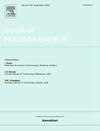The molten salt tritium transport experiment: A pumped fluoride salt loop for hydrogen isotope experimentation
IF 2.3
3区 工程技术
Q1 NUCLEAR SCIENCE & TECHNOLOGY
引用次数: 0
Abstract
Molten salt reactors and fusion reactors propose to use molten salt as coolants and breeder blanket materials. Tritium, however, poses safety concerns in both reactor types due to its ability to permeate through reactor materials creating the potential for environmental release. This article addresses the tritium transport phenomena in molten salts and presents the design and analysis of the Molten Salt Tritium Transport Experiment (MSTTE). MSTTE is a forced-convection fluoride salt loop intended to measure hydrogen isotope permeation through structural materials in a flowing salt system. Computational fluid dynamics analysis ensures fully developed salt flow in the permeation test section. MSTTE is modeled with MELCOR-TMAP to predict the permeation rate as a function of experimental variables such as source rate, salt flow rate, and salt temperature. Additionally, pressure drop analysis is conducted and finite-element analysis assesses thermal stress during loop operation to ensure the experiment’s safe design.
熔盐氚输运实验:用于氢同位素实验的泵浦氟化物盐环
熔盐反应堆和聚变反应堆建议使用熔盐作为冷却剂和增殖包层材料。然而,氚在这两种类型的反应堆中都存在安全问题,因为它能够渗透到反应堆材料中,从而产生向环境释放的可能性。本文讨论了氚在熔盐中的输运现象,并介绍了熔盐氚输运实验(MSTTE)的设计和分析。MSTTE是一种强制对流氟化物盐环,用于测量流动盐系统中氢同位素通过结构材料的渗透率。计算流体动力学分析保证了渗透试验段盐流充分发育。利用melco - tmap对MSTTE进行建模,以预测渗透率作为源速率、盐流速率和盐温等实验变量的函数。并进行压降分析和有限元分析,评估回路运行时的热应力,确保实验的安全设计。
本文章由计算机程序翻译,如有差异,请以英文原文为准。
求助全文
约1分钟内获得全文
求助全文
来源期刊

Annals of Nuclear Energy
工程技术-核科学技术
CiteScore
4.30
自引率
21.10%
发文量
632
审稿时长
7.3 months
期刊介绍:
Annals of Nuclear Energy provides an international medium for the communication of original research, ideas and developments in all areas of the field of nuclear energy science and technology. Its scope embraces nuclear fuel reserves, fuel cycles and cost, materials, processing, system and component technology (fission only), design and optimization, direct conversion of nuclear energy sources, environmental control, reactor physics, heat transfer and fluid dynamics, structural analysis, fuel management, future developments, nuclear fuel and safety, nuclear aerosol, neutron physics, computer technology (both software and hardware), risk assessment, radioactive waste disposal and reactor thermal hydraulics. Papers submitted to Annals need to demonstrate a clear link to nuclear power generation/nuclear engineering. Papers which deal with pure nuclear physics, pure health physics, imaging, or attenuation and shielding properties of concretes and various geological materials are not within the scope of the journal. Also, papers that deal with policy or economics are not within the scope of the journal.
 求助内容:
求助内容: 应助结果提醒方式:
应助结果提醒方式:


